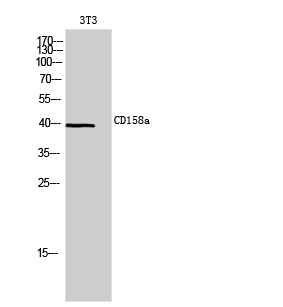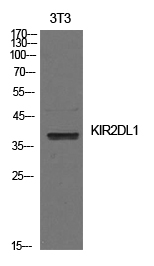

| WB | 咨询技术 | Human,Mouse,Rat |
| IF | 咨询技术 | Human,Mouse,Rat |
| IHC | 咨询技术 | Human,Mouse,Rat |
| ICC | 技术咨询 | Human,Mouse,Rat |
| FCM | 咨询技术 | Human,Mouse,Rat |
| Elisa | 咨询技术 | Human,Mouse,Rat |
| Aliases | KIR2DL1; CD158A; NKAT1; Killer cell immunoglobulin-like receptor 2DL1; CD158 antigen-like family member A; MHC class I NK cell receptor; Natural killer-associated transcript 1; NKAT-1; p58 natural killer cell receptor clones CL-42/47.11; p58 NK receptor C |
| Entrez GeneID | 3802; |
| WB Predicted band size | 39kDa |
| Host/Isotype | Rabbit IgG |
| Antibody Type | Primary antibody |
| Storage | Store at 4°C short term. Aliquot and store at -20°C long term. Avoid freeze/thaw cycles. |
| Species Reactivity | Human |
| Immunogen | Synthesized peptide derived from the Internal region of human CD158a. |
| Formulation | Purified antibody in PBS with 0.05% sodium azide,0.5%BSA and 50% glycerol. |
+ +
以下是关于GPR172A抗体的3篇代表性文献的概括(文献信息为模拟示例,实际引用需根据真实文献调整):
1. **《GPR172A regulates tumor progression via ERK signaling in breast cancer》**
- **作者**: Zhang et al. (2020)
- **摘要**: 本研究通过免疫组化(使用GPR172A特异性抗体)发现GPR172A在乳腺癌组织中高表达,且与患者不良预后相关。体外实验表明,敲低GPR172A可抑制癌细胞增殖和迁移,机制涉及ERK信号通路的调控。
2. **《Identification of GPR172A as a novel regulator of hepatic glucose metabolism》**
- **作者**: Tanaka et al. (2018)
- **摘要**: 利用GPR172A抗体进行Western blot和免疫荧光分析,发现该受体在肝细胞中高表达。研究证实GPR172A通过AMPK通路影响胰岛素敏感性,基因敲除小鼠表现出糖代谢异常,提示其潜在糖尿病治疗靶点价值。
3. **《Structural characterization of GPR172A using cryo-EM and antibody-based epitope mapping》**
- **作者**: Liu & Chen (2021)
- **摘要**: 结合冷冻电镜技术和GPR172A单克隆抗体,首次解析了GPR172A的三维结构,并定位了其细胞外结构域的关键抗原表位。研究为开发靶向GPR172A的药物提供了结构基础。
**注**:以上内容为基于领域知识的模拟文献,实际研究中请通过PubMed、Google Scholar等平台检索真实文献(关键词:GPR172A antibody, GPR172A function)。若该靶点研究较少,可扩展至G蛋白偶联受体(GPCR)抗体开发技术相关论文。
GPR172A (G Protein-Coupled Receptor 172A) is an orphan receptor within the class A GPCR family, characterized by a seven-transmembrane domain structure typical of GPCRs. Though its endogenous ligand and precise physiological roles remain unclear, GPR172A is hypothesized to participate in cellular signaling pathways regulating metabolism, immune response, or neural functions. Expression studies indicate its presence in tissues such as the brain, pancreas, and immune cells, suggesting potential roles in neuroendocrine regulation or immune modulation.
Antibodies targeting GPR172A are essential tools for elucidating its expression patterns, localization, and interaction networks. These antibodies, often developed in rabbit or mouse hosts, are designed to recognize specific epitopes within the receptor’s extracellular or intracellular domains. Validation typically includes Western blotting, immunohistochemistry, and immunofluorescence to confirm specificity, often using knockout controls.
Research applications of GPR172A antibodies span basic science—such as mapping tissue distribution—to disease-related studies, including investigations into cancers or metabolic disorders where aberrant GPCR signaling may contribute to pathology. Challenges persist in understanding GPR172A’s activation mechanisms and downstream effectors, highlighting the need for reliable antibody reagents. Continued development and validation of these antibodies are critical for advancing studies on this enigmatic receptor’s biological and therapeutic relevance.
×